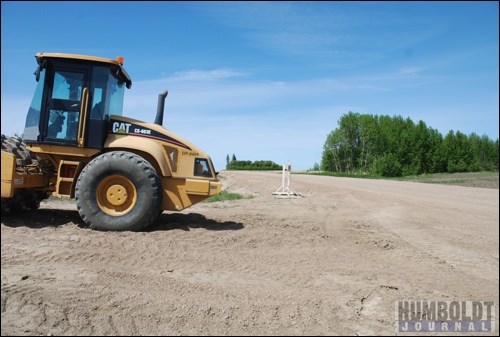Attention will be paid to highways around Humboldt this summer, but just how much depends on a few factors.
Work on Hwy. 368 between Lake Lenore and St. Brieux should be complete by the end of this summer, indicated Doug Wakabayashi, a spokesperson for the Saskatchewan Ministry of Highways and Infrastructure.
Crews have been out on the 25-kilometre section of road since May 2, and as of June 9, had only six kilometres of grading left to do.
Surfacing of the road was to begin once grading was done.
Depending on weather and contractor progress, the road should be finished by the fall, Wakabayashi stated.
It's been five years since commuters using Hwy. 368 began loudly complaining about its condition. The highway was filled with potholes and had been reduced to what looked like a muddy trail at some points, especially between Lake Lenore and St. Brieux.
Placards were placed illegally along the road, stating complaints about its condition.
At the time, about 415 vehicles travelled the road, the only main road between Lake Lenore and St. Brieux, every day.
In 2007, just prior to the provincial election, the NDP government announced funding to fix the roads, and work began soon after.
In 2009, the rebuilding of the section of road from Hwy. 5 north to Lake Lenore was finished.
Now, in 2011, the work is - fingers crossed - supposed to wrap up completely.
The total cost of the project is estimated at $21 million.
For travellers planning to use Hwy. 368 this summer, Wakabayashi indicated that traffic could be reduced to one lane in the work zone. There could also be local detours in some spots where it's just not practical to let one lane of traffic through, he added.
Wakabayashi was not aware of any water issues along the road this year, but noted that it has been wet in the area for the last few years. The water - both rainfall and the rising waters of Lenore Lake - has impacted the amount of work they have been able to get done, he added.
The same can be said for Hwy. 5.
Last summer, a section of road about eight kilometres west of Humboldt was flooded as the waters of Annie Lake, a natural slough area, rose to cover the highway.
Crews worked on raising the grade of the road beginning in July, and traffic was re-routed around the area for weeks while truckload after truckload of materials was hauled to the site from around the area.
Traffic was eventually allowed through that area once the road was raised out of the water, but work continued on that stretch of highway into the fall and early winter.
The road was paved in December, a time of year they don't normally pave, Wakabayashi noted.
"We got one lift (or layer) of asphalt down," he said. Normally, two layers are put down.
While the patch of newly paved road was, for the most part, in good shape over the winter, this spring the road got rough, and the speed limit along that area was dropped accordingly.
"It's been quite rough, people have noticed," he said. "Because part of the issue is that there is only one lift of pavement. The second lift will fix that."
But just when that second lift of pavement will go down is currently still in question.
"There is still some more settlement of the grade raise that needs to occur before we start the final paving," Wakabayashi said. "Depending on how long that takes, it could be into the 2012 season."
Because they had to raise the grade of the road while it was in open water, it will settle differently, Wakabayashi said, and not in a uniform manner, because of the amount of moisture that was in the base material.
The material has to settle, he indicated, before they can begin paving.
In the meantime, crews will be maintaining the road in that area, smoothing rough spots and ensuring that warning signs are in place.
The Ministry does not plan on having guard rails installed on that stretch of road, Wakabayashi added.
"It's pretty straight," he said.




